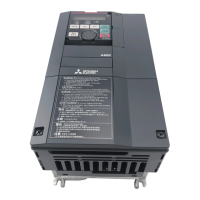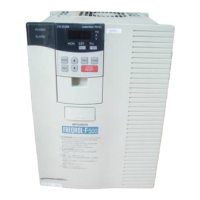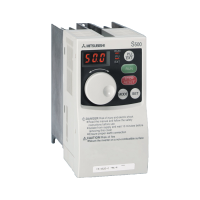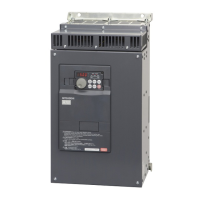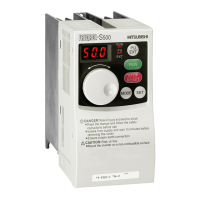Common specifications
SPECIFICATIONS
119
6
6.2 Common specifications
Control specifications
Control method
Soft-PWM control, high carrier frequency PWM control (selectable among V/F control (Optimum excitation control),
Advanced magnetic flux vector control (Advanced optimum excitation control) and PM motor control)
Output frequency range
0.2 to 590 Hz (The upper-limit frequency is 400 Hz under Advanced magnetic flux vector control, and PM motor control.)
Frequency
setting
resolution
Analog input
0.015 Hz/60 Hz (terminal 2, 4: 0 to 10 V/12 bits)
0.03 Hz/60 Hz (0 to 5 V/11 bits or 0 to 20 mA/approx. 11 bits for terminals 2 and 4, 0 to 10 V/12 bits for terminal 1)
0.06 Hz/60 Hz (0 to 5 V/11 bits for terminal 1)
Digital input
0.01 Hz
Frequency
accuracy
Analog input
Within 0.2% of the max. output frequency (25°C 10°C)
Digital input
Within 0.01% of the set output frequency
Voltage/frequency
characteristics
Base frequency can be set from 0 to 590 Hz. Constant-torque/variable-torque pattern or adjustable 5 points V/F can be
selected.
Starting
torque
Induction
motor
120% 0.5 Hz (Advanced magnetic flux vector control)
IPM motor
50%
Torque boost
Manual torque boost
Acceleration/deceleration
time setting
0 to 3600 s (acceleration and deceleration can be set individually), linear or S-pattern acceleration/deceleration mode,
backlash countermeasures acceleration/deceleration can be selected.
DC injection brake
(induction motor)
Operation frequency (0 to 120 Hz), operation time (0 to 10 s), operation voltage (0 to 30%) variable
Stall prevention operation
level
Activation range of stall prevention operation (0 to 150%). Whether to use the stall prevention or not can be selected. (V/F
control, Advanced magnetic flux vector control)
Operation specifications
Frequency
setting
signal
Analog input
Terminals 2 and 4: 0 to 10 V, 0 to 5 V, 4 to 20 mA (0 to 20 mA) are available.
Terminal 1: -10 to +10 V, -5 to 5 V are available.
Digital input
Input using the setting dial of the operation panel or the parameter unit
Four-digit BCD or 16-bit binary (when used with option FR-A8AX)
Start signal
Forward and reverse rotation or start signal automatic self-holding input (3-wire input) can be selected.
Input signals (twelve
terminals)
Low-speed operation command, Middle-speed operation command, High-speed operation command, Second function
selection, Terminal 4 input selection, Jog operation selection, Output stop, Start self-holding selection, Forward rotation
command, Reverse rotation command, Inverter reset
The input signal can be changed using Pr.178 to Pr.189 (input terminal function selection).
Pulse train input
100k pulses/s
Operational functions
Maximum and minimum frequency settings, multi-speed operation, acceleration/deceleration pattern, thermal protection,
DC injection brake, starting frequency, JOG operation, output stop (MRS), stall prevention, regeneration avoidance,
increased magnetic excitation deceleration, DC feeding, frequency jump, rotation display, automatic restart after
instantaneous power failure, electronic bypass sequence, remote setting, retry function, carrier frequency selection, fast-
response current limit, forward/reverse rotation prevention, operation mode selection, slip compensation, speed smoothing
control, traverse, auto tuning, applied motor selection, RS-485 communication, Ethernet communication, PID control, PID
pre-charge function, cooling fan operation selection, stop selection (deceleration stop/coasting), power-failure deceleration
stop function, PLC function, life diagnosis, maintenance timer, current average monitor, multiple rating, test run, 24 V power
supply input for control circuit, safety stop function, self power management, BACnet communication, PID gain tuning,
cleaning, load characteristics storage, emergency drive
Output signal
Open collector output
(five terminals)
Relay output
(two terminals)
Inverter running, Up to frequency, Instantaneous power failure/undervoltage, Overload warning, Output frequency
detection, Fault
The output signal can be changed using Pr.190 to Pr.196 (output terminal function selection).
Fault codes of the inverter can be output (4 bits) from the open collector.
Pulse train output
(FM type)
50k pulses/s
Indication
For meter
Pulse train
output
(FM type)
Max. 2.4 kHz: one terminal (output frequency)
The monitored item can be changed using Pr.54 FM/CA terminal function selection.
Current output
(CA type)
Max. 20 mADC: one terminal (output current)
The monitored item can be changed using Pr.54 FM/CA terminal function selection.
Voltage output
Max. 10 VDC: one terminal (output voltage)
The monitored item can be changed using Pr.158 AM terminal function selection.
Operation
panel
(FR-DU08)
Operating
status
Output frequency, output current, output voltage, frequency setting value
The monitored item can be changed using Pr.52 Operation panel main monitor selection.
Fault record
Fault record is displayed when a fault occurs. Past 8 fault records and the conditions immediately before the fault (output
voltage/current/frequency/cumulative energization time/year/month/date/time) are saved.
Protective/
warning
function
Protective
function
Overcurrent trip during acceleration, Overcurrent trip during constant speed, Overcurrent trip during deceleration or stop,
Regenerative overvoltage trip during acceleration, Regenerative overvoltage trip during constant speed, Regenerative
overvoltage trip during deceleration or stop, Inverter overload trip (electronic thermal O/L relay function), Motor overload trip
(electronic thermal O/L relay function), Heat sink overheat, Instantaneous power failure, Undervoltage, Input phase loss
,
Stall prevention stop, Loss of synchronism detection
, Upper limit fault detection, Lower limit fault detection, Output side
earth (ground) fault overcurrent, Output short circuit, Output phase loss, External thermal relay operation
, PTC thermistor
operation
, Option fault, Communication option fault, User definition error by the PLC function, Parameter storage device
fault (control circuit board), PU disconnection, Retry count excess
, CPU fault, Operation panel power supply short circuit/
RS-485 terminals power supply short circuit, 24 VDC power fault, Abnormal output current detection
, Inrush current limit
circuit fault, Ethernet communication fault
, Communication fault (inverter), Analog input fault, USB communication fault,
Safety circuit fault, Abnormal internal temperature, Internal circuit fault, Overspeed occurrence
, 4 mA input fault, Pre-
charge fault
, PID signal fault
Warning
function
Operation panel lock, Password locked, Parameter write error, Copy operation error, Stall prevention (overcurrent), Stall
prevention (overvoltage), Electronic thermal relay function pre-alarm, PU stop, Continuous operation during communication
fault, Parameter copy, Safety stop, Maintenance timer 1 to 3
, USB host error, Load fault warning, Emergency drive in
operation, Fan alarm, Internal-circulation fan alarm, 24 V external power supply operation, Ethernet communication fault
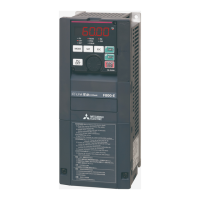
